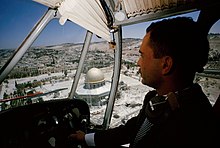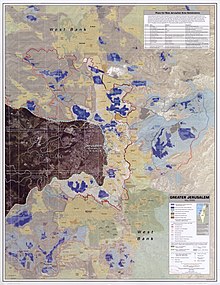East Jerusalem
The actual mapping suggests otherwise, according to Michael Dumper, who states that the peculiar "hook" on the western electoral borders was a gerrymander made to include as many new Jewish neighbourhoods on that side as possible, while keeping outside of the boundaries Arab villages.
[35] During the Battle for Jerusalem, fighting in the Jewish quarter between the Jordanian Arab Legion and the IDF, Irgun and Lehi had been particularly fierce, leaving the zone in ruins.
[36] The Jordanian army is said to have blown up, three days after conquering the area, what remained of the Hurva Synagogue, which had served both as a civilian refuge and Israeli military post.
After the surrender to the Jordanian Arab Legion, the Red Cross, which had been invested with the authority to protect many major sites,[d] oversaw the evacuation westwards through Zion Gate of some 1,300 Jews from the Old Quarter.
[39] The only eastern area of the city that remained in Israeli hands throughout the 19 years of Jordanian rule was Mount Scopus, where the Hebrew University is located, which formed an enclave during that period.
Likewise, Palestinians[e] living in such western Jerusalem neighbourhoods as Qatamon, Talbiya, Baq'a, 'Ayn Karim, Lifta[41] and Malha either fled or were forced out,[f] many of them seeking refuge in the Old City.
[47] The municipal boundaries of Jordanian East Jerusalem were expanded to cover 6 square kilometres (2.3 sq mi) by taking in the nearby villages of Silwan, Ras al-Amud Aqabat al-Suwana, 'Ard al-Samar and parts of Shuafat.
Repairs were delayed a decade until a consensus was achieved between the Greek, Latin, and Armenian clerics (excluding the Copts), with Jordan playing a pivotal role as mediator.
[51] In the early 1960s, Jordan gave the go-ahead for the construction of the Intercontinental Hotel on the Mount of Olives on waqf terrain expropriated in 1952 from the family of Abd al-Razzaq al-'Alami.
[52][i] Tourism in Palestine had long been an undeveloped and marginal sector of the local economy, and, with the division of Jerusalem after 1948, political issues impeded its commercial development as a tourist destination.
In November 1967, United Nations Security Council Resolution 242 was passed, calling for Israel to withdraw "from territories occupied in the recent conflict" in exchange for peace treaties.
[65] When occupied by Israel after the 1967 Six-Day War, East Jerusalem, with expanded borders, came under direct Israeli rule, an effective de facto annexation.
[p] According to B'Tselem, as of 2017, the 370,000 overcrowded West Bankers in this zone are bereft of any control over their lives, given extreme restrictions on the movement of residents without any advance notice.
[citation needed] In the Oslo Accords, the PLO conceded that the question of East Jerusalem be excluded from the interim agreement, and be left to final status negotiations.
[68] In a reply to the resolution, Israel denied these measures constituted annexation and contended that it merely wanted to deliver services to its inhabitants and protect the Holy Places.
[111] According to lawyers, the annexation of an area would automatically make its inhabitants Israeli citizens,[61] a condition lacking and East Jerusalem's Palestinians have the status of "permanent residents".
The 1997 Beilin–Eitan Agreement between some members of the Likud block and Yossi Beilin, representing Labor, which envisioned for final negotiations a limited autonomy to a demilitarized "Palestinian entity" surrounded on all sides by Israel, stated that all of Jerusalem would remain unified under Israeli sovereignty.
An exchange of neighbourhoods was envisaged, with Israel taking sovereignty over Ma'ale Adumim, Givat Ze'ev and Gush Etzion, while excluding areas earlier included, such as Sur Baher, Beit Hanina and Shu'afat.
[61] The Israeli-Palestinian Declaration of Principles (Oslo I), signed 13 September 1993, deferred the settlement of the permanent status of Jerusalem to the final stages of negotiations between Israel and the Palestinians.
Arafat concurred with this Israeli proposal, and Israel asserted a pre-condition, namely, that all Palestinian institutions be removed from Jerusalem proper and transferred to Abu Dis.
[137] According to the American Friends Service Committee and Marshall J. Breger, such restrictions on Palestinian planning and development in East Jerusalem are part of Israel's policy of promoting a Jewish majority in the city.
[138][139] On 13 May 2007, the Israeli Cabinet began a discussion regarding a proposal to expand Israel's presence in East Jerusalem and boost its economy so as to attract Jewish settlers.
As Arab residents are hard-pressed to obtain building permits to develop existing infrastructure or housing in East Jerusalem, this proposition has received much criticism.
[142] A European Union report of March 2010 has asserted that 93,000 East Jerusalem Palestinians, 33% of the total, are at risk of losing their homes, given Israeli building restrictions imposed on them, with only 13% of the municipal territory allowed for their housing, as opposed to 53% for Jewish settlement.
[164][165] In March 2009, Israel's Internal Security Minister responded with a number of injunctions, banning scheduled cultural events in the framework of this designation in Jerusalem, Nazareth and in other parts of the Palestinian Territories.
[168] On 29 June 2013, Israel denied members of the Ramallah Orchestra from the Al Kamandjâti music school access to East Jerusalem, where they were to give a concert in the French St. Anne's church.
[169][170] East Jerusalem has been recognised as an Important Bird Area (IBA) by BirdLife International because its walls and old buildings provide nesting sites for a population of lesser kestrels, with some 35–40 breeding pairs estimated in 1991.
[172][173] Major problems were said to be restrictions on movement of goods and people, which Israel says are imposed for security reasons, and Israeli neglect of "dire socio-economic conditions".
[172][173] UNCTAD said "the Israeli government could go much further in meeting its obligations as an occupying power by acting with vigour to improve the economic conditions in East Jerusalem and the well-being of its Palestinian residents".
In 2012, the classroom shortage was reportedly 1,100, due to what Haaretz described as "years of intentional neglect of East Jerusalem schools, which serve the Arab population by the Education Ministry and the city".















